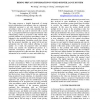Free Online Productivity Tools
i2Speak
i2Symbol
i2OCR
iTex2Img
iWeb2Print
iWeb2Shot
i2Type
iPdf2Split
iPdf2Merge
i2Bopomofo
i2Arabic
i2Style
i2Image
i2PDF
iLatex2Rtf
Sci2ools
100
click to vote
ICIP
2005
IEEE
2005
IEEE
Hiding privacy information in video surveillance system
This paper proposes a detailed framework of storing privacy information in surveillance video as a watermark. Authorized personnel is not only removed from the surveillance video as in [1] but also embedded into the video itself, which can only be retrieved with a secrete key. A perceptual-model-based compressed domain video watermarking scheme is proposed to deal with the huge payload problem in the proposed surveillance system. A signature is also embedded into the header of the video as in [2] for authentication. Simulation results have shown that the proposed algorithm can embed all the privacy information into the video without affecting its visual quality. As a result, the proposed video surveillance system can monitor the unauthorized persons in a restricted environment, protect the privacy of the authorized persons but, at the same time, allow the privacy information to be revealed in a secure and reliable way.
Related Content
| Added | 23 Oct 2009 |
| Updated | 14 Nov 2009 |
| Type | Conference |
| Year | 2005 |
| Where | ICIP |
| Authors | Wei Zhang, Sen-Ching S. Cheung, Minghua Chen |
Comments (0)

